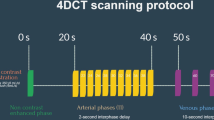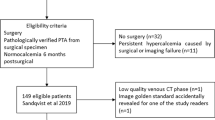Abstract
Introduction
The aims of the study were to compare the diagnostic performance of a combination of virtual non-contrast (VNC) images and arterial images obtained from a single-phase dual-energy CT (DECT) acquisition and standard non-contrast and arterial images from a biphasic protocol and to study the potential radiation dose reduction of the former approach.
Methods
All DECT examinations performed for evaluation of parathyroid adenomas during a 13-month period were retrospectively reviewed. An initial single-energy unenhanced acquisition was followed by a dual-energy arterial phase acquisition. “Virtual non-contrast images” were generated from the dual-energy acquisition. Two independent and blinded radiologists evaluated three different sets of images during three reading sessions: single arterial phase, single-phase DECT (virtual non-contrast and arterial phase), and standard biphasic protocol (true non-contrast and arterial phase). The accuracy of interpretation in lateralizing an adenoma to the side of the neck and localizing it to a quadrant in the neck was evaluated.
Results
Sixty patients (mean age, 65.5 years; age range, 38–87 years) were included in the study. The lateralization and localization accuracy, sensitivity, and positive predicted value (PPV) and negative predicted value (NPV) of the different image datasets were comparable. The combination of VNC and arterial images was more specific than arterial images alone to lateralize a parathyroid lesion (OR = 1.93, p = 0.043). The use of the single-phase protocol resulted in a calculated radiation exposure reduction of 52.8 %.
Conclusions
Virtual non-contrast and arterial images from a single DECT acquisition showed similar diagnostic accuracy than a biphasic protocol, providing a significant dose reduction.



Similar content being viewed by others
References
Kelly HR, Hamberg LM, Hunter GJ (2014) 4D-CT for preoperative localization of abnormal parathyroid glands in patients with hyperparathyroidism: accuracy and ability to stratify patients by unilateral versus bilateral disease in surgery-naive and re-exploration patients. AJNR Am J Neuroradiol 35:176–181
Chazen JL, Gupta A, Dunning A, et al. (2012) Diagnostic accuracy of 4D-CT for parathyroid adenomas and hyperplasia. AJNR Am J Neuroradiol 33:429–433
Hunter GJ, Schellingerhout D, Vu TH, et al. (2012) Accuracy of four-dimensional CT for the localization of abnormal parathyroid glands in patients with primary hyperparathyroidism. Radiology 264:789–795
Eichhorn-Wharry LI, Carlin AM, Talpos GB (2011) Mild hypercalcemia: an indication to select 4-dimensional computed tomography scan for preoperative localization of parathyroid adenomas. Am J Surg 201:334–338
Starker LF, Mahajan A, Bjorklund P, et al. (2011) 4D parathyroid CT as the initial localization study for patients with de novo primary hyperparathyroidism. Ann Surg Oncol 18:1723–1728
Rodgers SE, Hunter GJ, Hamberg LM, et al. (2006) Improved preoperative planning for directed parathyroidectomy with 4-dimensional computed tomography. Surgery 140:932–940
Hoang JK, Reiman RE, Nguyen GB, et al. (2015) Lifetime attributable risk of cancer from radiation exposure during parathyroid imaging: comparison of 4D CT and parathyroid scintigraphy. AJR Am J Roentgenol 204:W579–W585
Madorin CA, Owen R, Coakley B, et al. (2013) Comparison of radiation exposure and cost between dynamic computed tomography and sestamibi scintigraphy for preoperative localization of parathyroid lesions. JAMA Surg 148:500–503
Mahajan A, Starker LF, Ghita M, et al. (2012) Parathyroid four-dimensional computed tomography: Evaluation of radiation dose exposure during preoperative localization of parathyroid tumors in primary hyperparathyroidism. World J Surg 36:1335–1339
Hoang JK, Sung WK, Bahl M, et al. (2014) How to perform parathyroid 4D CT: tips and traps for technique and interpretation. Radiology 270:15–24
Raghavan P, Durst CR, Ornan DA, et al. (2014) Dynamic CT for parathyroid disease: are multiple phases necessary? AJNR Am J Neuroradiol 35:1959–1964
Johnson TR, Krauss B, Sedlmair M, et al. (2007) Material differentiation by dual energy CT: initial experience. Eur Radiol 17:1510–1507
Roskies M, Liu X, Hier MP, et al. (2015) Three-phase dual-energy CT scan as a feasible salvage imaging modality for the identification of non-localizing parathyroid adenomas: a prospective study. J Otolaryngol Head Neck Surg 44:44
Huda W, Ogden KM, Khorasani MR (2008) Converting dose-length product to effective dose at CT. Radiology 248:995–1003
Acknowledgments
The authors would like to thank Deb Grady, lead CT/QA technologist, and Winston Evatt, data analyst at the Advanced Visualization Laboratory in the Department of Radiology and Medical Imaging at the University of Virginia, for their support and wonderful work.
Author information
Authors and Affiliations
Corresponding author
Ethics declarations
We declare that all human and animal studies have been approved by the institutional review board and have therefore been performed in accordance with the ethical standards laid down in the 1964 Declaration of Helsinki and its later amendments. We declare that all patients gave informed consent prior to inclusion in this study.
Conflict of interest
We declare that we have no conflict of interest.
Rights and permissions
About this article
Cite this article
Leiva-Salinas, C., Flors, L., Durst, C.R. et al. Detection of parathyroid adenomas using a monophasic dual-energy computed tomography acquisition: diagnostic performance and potential radiation dose reduction. Neuroradiology 58, 1135–1141 (2016). https://doi.org/10.1007/s00234-016-1736-4
Received:
Accepted:
Published:
Issue Date:
DOI: https://doi.org/10.1007/s00234-016-1736-4




